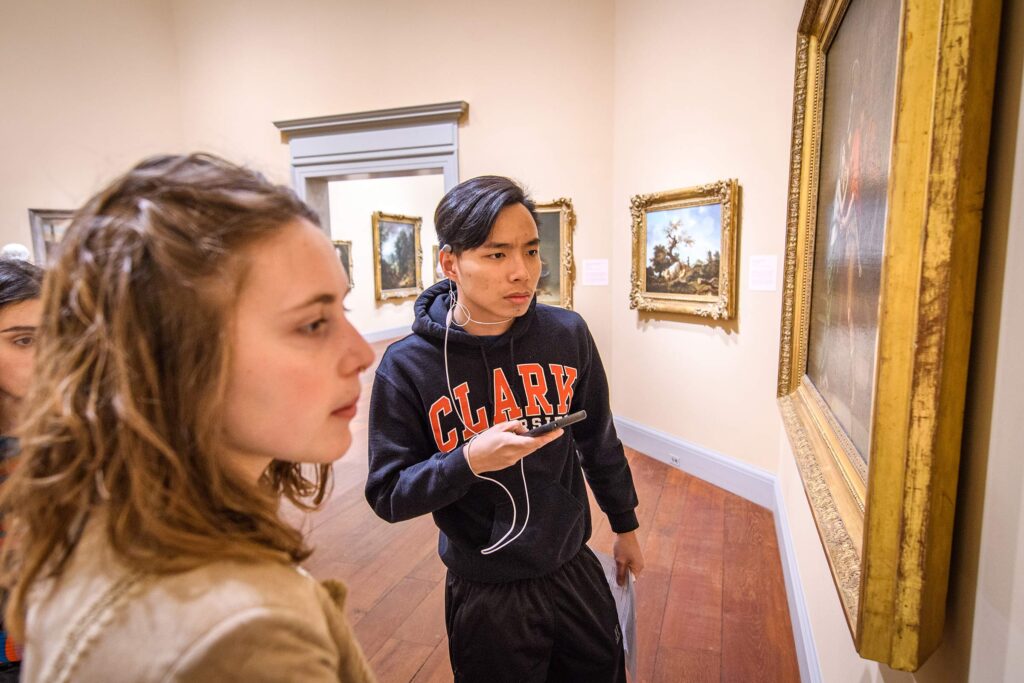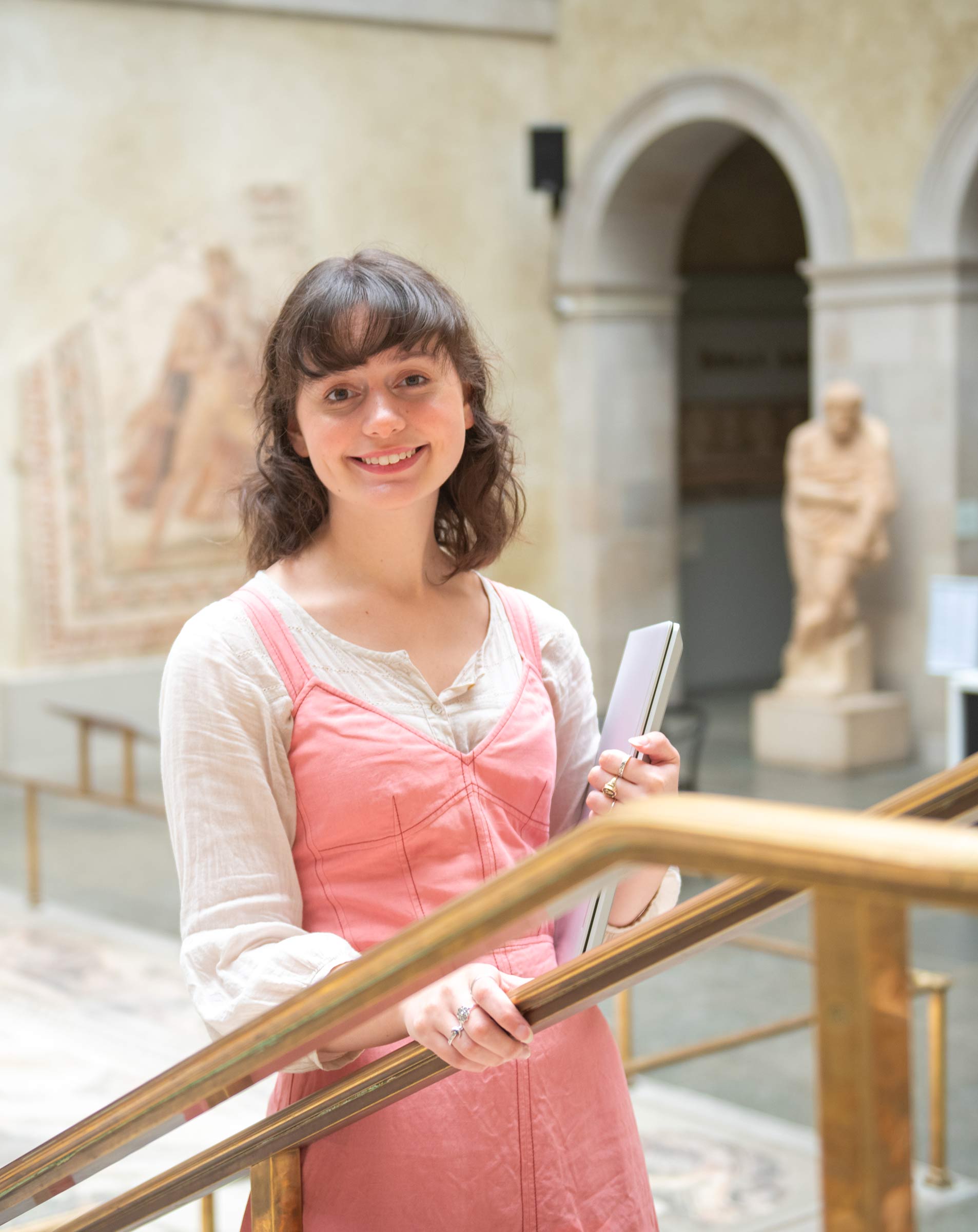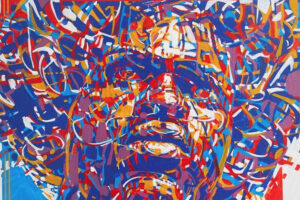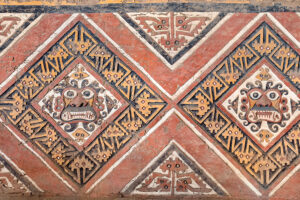When you study the history of art, you study the history of power, identity, and culture in human societies across the globe. Leading to a bachelor of arts degree, the art history major looks at creative works in context, tracing the human experience throughout the ages in relation to the visual art, sculpture, and architecture of a given time.


Why study art history at Clark?
- Find inspiration and pursue internships in a state brimming with renowned arts institutions, including Boston-based treasures such as the Museum of Fine Arts and the Isabella Stewart Gardner Museum; the deCordova Sculpture Park and Museum in Lincoln; and the Massachusetts Museum of Contemporary Art in North Adams.
- Become active in Worcester’s own arts community, which includes the Worcester Art Museum (free admission for Clarkies); ArtsWorcester, supporting contemporary artists in the city; and Preservation Worcester, which advocates for Worcester’s amazing architectural heritage.
- Benefit from a wealth of opportunities to apply and deepen your knowledge — whether by serving as a gallery intern at Clark’s Schiltkamp Gallery, interviewing local artists, or exploring conservation techniques at Clark’s Archives and Special Collections.
- Create and collaborate in the wider context of Clark’s Visual and Performing Arts Department (V&PA), a tight-knit community that includes students majoring in art history; media, culture, and the arts; music; screen studies; studio art; and theatre arts.
- Apply
- Request Info
Are you ready to take the first step?
Featured Courses

Byzantium, Orthodoxy, and the Medieval Mediterranean World
This course will examine the art and architecture of Byzantium from the fourth to the fifteenth centuries as a chronological narrative inflected by interactions amongst the myriad cultures of the Mediterranean.

Art from 1940 to 1970: Modernism and Its Discontents
This course traces the disintegrating confidence of mid-twentieth-century modernism, examining how movements like neo-Dadaism, pop art, minimalism, land art, and AfriCOBRA critiqued modernism and postwar society.

Art and Architecture of the Ancient Americas
Through case studies and field trips to local museums, you’ll examine how certain societies of the early Americas created objects and buildings that gave meaning to their sense of self, community, and world.
As an art history major, you’ll complete at least 11 courses — ten in art history and one in studio art. The program offers courses in ancient, Renaissance/Baroque, modern, and non-Western art.
You should plan to take at least one course in non-Western art, and at least two courses in each of the other areas. All students take three core courses:
- From the Stone Age to Our Age: Monuments and Masterpieces of Western Art
- Art, the Public, and the History of Worcester (a Problems of Practice course)
- The Art of Art History: Teaching and Methods (senior capstone)
Career Communities are industry-focused groups designed to support your professional exploration and narrow down your career interests within specific fields. You’ll connect to opportunities, professionals, and information that will support your career development. The following communities may be of interest:
Arts, Media, Design, and Communications
Non-Profit, Human Services, and Education
Collection and Exhibitions Manager
Art Institute of Chicago, Chicago, IL
Director of American Art
Bonhams Auction House, New York, N.Y.
Manager of Visual Arts Programs
New York Historical Society, N.Y.
Manager of Group Programs
Museum of Modern Art, New York. N.Y.
Development Associate
Boston Public Library Foundation, Boston, MA
Outreach Coordinator
Black Mountain College, Asheville, N.C.
The Clark Experience
The Clark Experience brings together the exceptional education you’ll receive in the classroom and so much more. Through focus and flexibility, it ensures you’ll leave Clark with the creativity, confidence, and resilience to succeed and lead a life of meaning and consequence.
Frequently Asked Questions
What can I do with a major in art history?
At Clark you’ll get more than a great education; you’ll also be prepared for a long, productive career and life of consequence. And once you’ve completed your degree, you can join other Clark alumni who have gone on to work for great organizations and attend some of the best graduate schools in the world.
Art history majors at Clark have gone on to graduate study at Harvard University, the School of the Art Institute of Chicago; and the Courtauld Institute of Art, London. They’ve also been awarded Fulbrights to support research or teaching abroad and serve on the curatorial, registrarial, and educational teams at major museums and historical societies, including the Museum of Modern Art, in New York; the Boston Public Library Foundation, and the New York Historical Society.
What skills will I learn from art history?
- How to visually analyze a work of art
- How to write and speak coherently and persuasively
- How to integrate different kinds of knowledge (visual analysis, historical documentation, content learned from scholarly articles) into a coherent, persuasive paper
Are art history majors eligible for academic achievement awards?
Patricia M. Plamondon Undergraduate Award in Visual and Performing Arts
The Patricia M. Plamondon Award is given to juniors and seniors who have demonstrated their talent in and commitment to the arts and for whom the award will serve to enhance their studies, research, or project-related travel. The award is made annually by a vote of the full-time faculty of the Department of Visual and Performing Arts.
Is there an honors program for art history majors?
During your junior year, you might be accepted into the art history honors program. Joining the program means you’ll work closely with a professor to create a thesis on a topic of your choice. Examples of recent honors thesis topics are:
- The Birth of a Venetian Venus: From the Page to the Painting
- Burnside Fountain: A Story of Failure
- Queer Relationality: Ray Johnson’s Silhouettes as Glyphs, Dumps, Letters and Holes
- “The Nation Which Rejects the Home”: Katherine Dreier and a New Museum for the American Home
- A Comparison Between French and Italian Books of Hours: The Tension Between Female Agency and Idealized Womanhood
- The Triumph of Jean-Michel Basquiat: The Black Self in Conflict with Modernity
- Primitivist Nostalgia and Postwar Solitude: The Emotionalism of Ernst Ludwig Kirchner’s 1924 Umbra Vitae Woodcuts
- The Temple at Antiochia ad Cragum: An Examination of Roman Imperial Architectural Mouldings
- Connoisseurship 101: An Exercise in Attribution and Understanding in the Worcester Art Museum’s “Antonio Montalvo’s Wife and One of His Sons” by a follower of Agnolo Bronzino (1503-1572)
Be a force for change.
Come study at a small research university with a strong liberal arts core.

